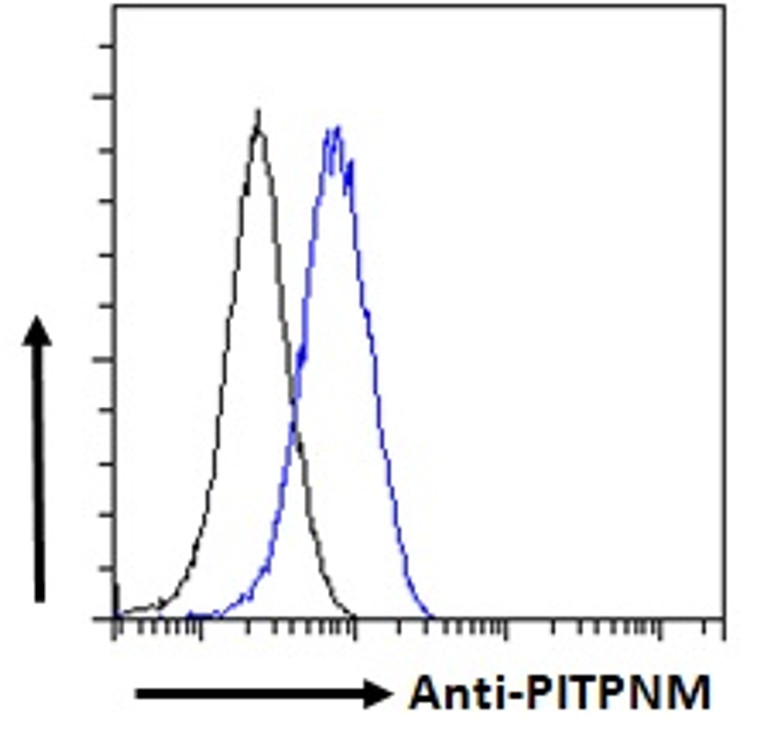| Host: |
Goat |
| Applications: |
Pep-ELISA/IF/FC |
| Reactivity: |
Human/Mouse/Dog/Cow |
| Note: |
STRICTLY FOR FURTHER SCIENTIFIC RESEARCH USE ONLY (RUO). MUST NOT TO BE USED IN DIAGNOSTIC OR THERAPEUTIC APPLICATIONS. |
| Short Description: |
Goat polyclonal antibody anti-PITPNM/PITPNM1 (C-Term) is suitable for use in ELISA, Immunofluorescence and Flow Cytometry research applications. |
| Clonality: |
Polyclonal |
| Conjugation: |
Unconjugated |
| Isotype: |
IgG |
| Formulation: |
0.5 mg/ml in Tris saline, 0.02% sodium azide, pH7.3 with 0.5% bovine serum albumin. NA |
| Purification: |
Purified from goat serum by ammonium sulphate precipitation followed by antigen affinity chromatography using the immunizing peptide. |
| Concentration: |
0.5 mg/mL |
| Dilution Range: |
IF-Strong expression of the protein seen in the cytoplasm and endoplasmic reticulum of A549 cells. 10µg/mlELISA-antibody detection limit dilution 1:8000. |
| Storage Instruction: |
Store at-20°C on receipt and minimise freeze-thaw cycles. |
| Gene Symbol: |
PITPNM1 |
| Gene ID: |
9600 |
| Uniprot ID: |
PITM1_HUMAN |
| Immunogen Region: |
C-Term |
| Accession Number: |
NP_004901.2; NP_001124320.1 |
| Specificity: |
This antibody is expected to recognise both reported isoforms. |
| Immunogen Sequence: |
KARSISLKLDSEE |
| Post Translational Modifications | Phosphorylated on multiple sites by CDK1 at the onset of mitosis. Phosphorylation facilitates dissociation from the Golgi complex and is required for interaction with PLK1. Phosphorylated on threonine residues upon treatment with oleic acid. Phosphorylated on tyrosine residues by PTK2B. |
| Function | Catalyzes the transfer of phosphatidylinositol (PI) between membranes. Binds PI, phosphatidylcholine (PC) and phosphatidic acid (PA) with the binding affinity order of PI > PA > PC. Regulates RHOA activity, and plays a role in cytoskeleton remodeling. Necessary for normal completion of cytokinesis. Plays a role in maintaining normal diacylglycerol levels in the Golgi apparatus. Necessary for maintaining the normal structure of the endoplasmic reticulum and the Golgi apparatus. Required for protein export from the endoplasmic reticulum and the Golgi. Binds calcium ions. |
| Protein Name | Membrane-Associated Phosphatidylinositol Transfer Protein 1Drosophila Retinal Degeneration B HomologPhosphatidylinositol Transfer Protein - Membrane-Associated 1Pitpnm 1Pyk2 N-Terminal Domain-Interacting Receptor 2Nir-2 |
| Database Links | Reactome: R-HSA-1483226 |
| Cellular Localisation | CytoplasmGolgi ApparatusGolgi Stack MembranePeripheral Membrane ProteinEndoplasmic Reticulum MembraneLipid DropletCleavage FurrowMidbodyPeripheral Membrane Protein Associated With Golgi Stacks In Interphase CellsA Minor Proportion Is Associated With The Endoplasmic ReticulumAssociated With Lipid DropletsDissociates From The Golgi Early On In Mitosis And Localizes To The Cleavage Furrow And Midbody During Cytokinesis |
| Alternative Antibody Names | Anti-Membrane-Associated Phosphatidylinositol Transfer Protein 1 antibodyAnti-Drosophila Retinal Degeneration B Homolog antibodyAnti-Phosphatidylinositol Transfer Protein - Membrane-Associated 1 antibodyAnti-Pitpnm 1 antibodyAnti-Pyk2 N-Terminal Domain-Interacting Receptor 2 antibodyAnti-Nir-2 antibodyAnti-PITPNM1 antibodyAnti-DRES9 antibodyAnti-NIR2 antibodyAnti-PITPNM antibody |
Information sourced from Uniprot.org
12 months for antibodies. 6 months for ELISA Kits. Please see website T&Cs for further guidance








